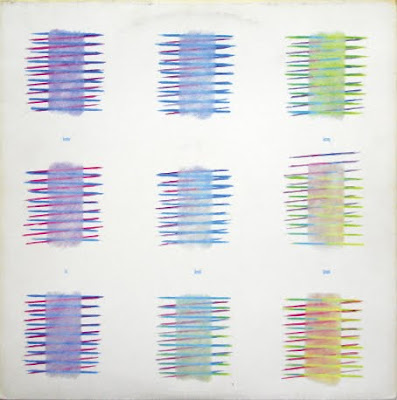Date: 13/12/07
By: Stefan Schneider
Durutti Column – Another Setting (Factory 1983)
Design by Jackie Williams (drawing/stencil), Mark Farrow (Graphic design)
Inside the sleeve of this album is a cardboard sheet with rectangular stencilled shapes. It’s printed on one side only, with all the album credits in the middle of the design, written in a small Grotesque typeface, and with four drawings that were supposedly made with crayons and watercolours.
It must have been one of the very few Factory record sleeves not done by Peter Saville: it credits Jackie Williams for the drawings and stencil, and Mark Farrow as the designer.
When you pull the sheet out of the sleeve, it looks naked, fragile and unprotected, and to a degree almost disappointing. It offers nothing much to read or to look at that would make such a luxurious supplement appear reasonable. Was it merely a gimmick? What about the missing elements? Are the most crucial parts the missing ones? The shapes of the cut-outs don’t reflect any kind of special craftsmanship. Its simplicity matches the pastel drawings on the front sleeve, which look like coloured reflections on water. The label of the record shows a black and white photograph of Vini Reilly swimming in a pool.
The sleeve and especially the stencil sheet left me quite uncertain about how to regard it and what to do with it. Since the stencil did not seem to be of any practical value, I started to look at it like something you find on the street, which you can’t really figure out what it is, or figure out if it’s worth taking home to give it a closer look.
Maybe like something that needs to be looked at without any additional information, something which gives you the feeling that you must forget all your previous knowledge about forms of art/design/music, and look at it
from a zero starting point.
I bought Another Setting around the time it came out, when I was already very familiar with the music of Vini Reilly. I felt very close to it. The fact that Durutti Column was never a full group and dealt with an incomplete line-up (no bass player, no keyboardist) gave the music a feeling of being unprotected and vulnerable. A music and a voice that left things openended in order to give space to the listener to fill it with his or her own wishes, hopes or physical activity. Or to accept it as it is in its bare radical softness.
Holding the stencil in my hand was probably the point when I started to doubt that I was as close to the music of Durutti Column as I thought I was. It gave me the feeling that I might not understand very much of what the guy was doing when he created such unfamiliar shapes. I had to examine my relationship towards it, which made me feel unprotected. In 1983, Another Setting was one of the very few records (besides maybe Felt’s Crumbling The Antiseptic Beauty) that made me want to create my own sounds. All I did around that time was some very simple field recordings, which I made with a borrowed tape recorder. Of all of these recordings, what I loved most was an electric hum of a long distance line that I heard on a field outside Düsseldorf: a constant drone that was floating somewhere in the humid air. This was my perfect version of the Durutti Column feeling. I lost the recording of that hum and, instead of going back to the site to record it, I started to reconstruct it with a guitar and a delay pedal.
To lose your fear of showing yourself unprotected and vulnerable is of fundamental importance to me for any kind of art production. The moment when I finish a new record, I’m almost always disappointed with the outcome, and I have to deal with this disappointment before the record release. I almost feel like a fool because I come to realise that I wanted to do it that way – but I did not want it to sound like this. A sensation I also found much later in the installation Show Your Wound by Joseph Beuys. The sleeve of Another Setting was an early encounter with all this for me.
Stefan Schneider is a member of To Rococo Rot and Mapstation.


No comments:
Post a Comment